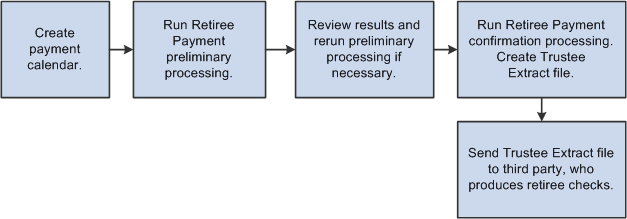Understanding the Pension Payment Process
Pension Administration gathers and exports payment information. However, it assumes that a trustee or other third-party produces the pension checks and handles all W-2 and 1099 reporting.
Several steps are required to process retiree pension payments:
Create a payment calendar, where you assign a run ID to each pay period.
You can set up separate payment calendars for each plan, or you can set up a single payment calendar for all plans.
Run the Retiree Payment COBOL SQL process (PAPPPYMT) in Preliminary Processing mode.
The Retiree Payment process reads the relevant payment data from both the regular and one-time payment schedules.
Review and edit the preliminary results.
You can rerun the process as often as necessary in Preliminary Processing mode.
Run the Retiree Payment process in Confirmation Processing mode.
The Retiree Payment process confirms the results of the preliminary processing and updates retiree pension statuses.
The Trustee Extract process uses the payment information that the Retiree Payment process gathers. It writes the data to the Trustee Extract file, which you can transmit to the third-party who produces the retiree checks.
Send the trustee extract file to the third party who produces retiree checks.
The following diagram illustrates the flow of the pension payment process from creating the payment calendar to sending a trustee extract file to a third party:
This diagram illustrates the pension payment process from creating the payment calendar to sending a trustee extract file to a third party.

Note: PeopleSoft Payroll Interface includes a data import feature that you can use to import pension check data that is created by a trustee. You import this check data for viewing and ad hoc reporting only—not for issuing 1099-Rs. The system assumes that 1099-Rs are issued by the trustee.